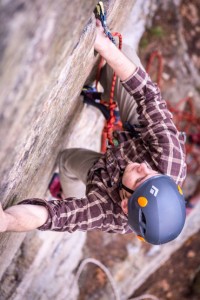
If you want to learn how to climb you can probably find a rock gym to get introduced to the sport. This isn’t how it’s always been though. “You could only climb when the weather was good and you could drive to New Hampshire,” said Kat Waterhouse, director of marketing for Rock Spot Climbing in Lincoln.
Waterhouse explained how necessary it is to learn to climb outside with a seasoned climber or a hired guide. The pioneers of the sport needed years to build up enough experience to attempt famous climbs like the prow of Cathedral Ledge or VMC Direct on Cannon Cliff. For many people their first introduction to outdoor climbing is either bouldering or top-roping.
With the help of a spotter and one or more big cushions called crash pads, bouldering enthusiasts are protected from falls. “The bouldering scene in Rhode Island started in the ’70s with a bunch of Brown students,” said Kris Kearney, Manager of Rock Spot Climbing in Lincoln. Bouldering has become more popular over the last couple decades and recent years have seen a push in southern RI to develop access to bouldering in areas like Connors Farm in Smithfield.
In top-roping, top-ropes are set up by an experienced climber and are strung through an anchor above a climb. A climber ties into one end of the rope and a belayer clips into the other end.
Belaying consists of managing the slack in a rope system to keep the climber safe; the belayer literally holds a climber’s life in their hands. As the climber ascends the route, the belayer removes slack by pulling excess rope through a friction device like an ATC or a GriGri. When a climber falls, the belayer holds the brake end of the rope to keep it from sliding through their belay device. Because either person is effectively on opposite sides of a pulley system, the belayer isn’t catching the entire weight of the climber.
In lead climbing, the rope is piled at the bottom of the cliff and as the climber progresses up the wall, the belayer lets slack out. The climber either sets their own protection into the rock or clips into bolts drilled into the wall. The downside to this kind of climbing is that leader falls are much longer — twice the distance from the last piece of protection they clipped into.
In gym climbing, you can practice everything from strength conditioning to bouldering, top-roping and lead climbing. “Kids can come in and have an after school class, and become really strong indoors,” Waterhouse said.
Thanks to indoor facilities, climbers can train all types of holds and techniques to target weaknesses that would normally require trips to multiple crags to work on. Climbing isn’t just for athletes who can do one finger pull-ups either. The majority of the people who work out at rock gyms don’t end up climbing outside. They use the gym as an alternative way to stay in shape. “You can come into it at any age,” said Kearney. “My climbing partner started when he was 50. He’s 58 now and he’s a really accomplished climber.”
Check out these local climbing destinations:
Rhode Island:
Rock Spot, Lincoln & Peacedale
Arcadia Management Area
Lincoln Woods
Connors Farm
Rockville Management Area
Cconnecticut:
Ross Pond in Killingly
Lantern Hill North Stonington in the Pachaug State Forest
North Stonington
More Posts by The Author:
So You Want to Plant a Garden …
The 48 Hour Film Project: Suffering in the Name of Art
Hitting the Trails Safely
A Tour Through RI Vineyards
Amos House & PVD Roller Derby 5k Gored for Good


